The legacy of the MAJORANA DEMONSTRATOR
Researchers publish “final word on the MAJORANA DEMONSTRATOR,” reflect on mission accomplished
For nearly six years, the Majorana Demonstrator quietly listened to the Universe. Nearly a mile underground at the Sanford Underground Research Facility (SURF), in Lead, South Dakota, the experiment collected data that could answer one of the most perplexing questions in physics: Why is the Universe filled with something instead of nothing?
With the publication of the experiment’s final results, humanity is one step closer to finding that answer.
On Feb. 10, 2023, the Majorana Collaboration published their final results in Physical Review Letters. The experiment ran from 2015 through 2021 and was managed by Oak Ridge National Laboratory (ORNL) for the U.S. Department of Energy Office of Nuclear Physics with support from the National Science Foundation.
The final results prove that the techniques used by the collaboration could be deployed on a much larger scale to search for the rare, never-before-seen decay that could help explain the existence of matter in our Universe.
“The purpose of the Majorana Demonstrator was to prove that our detector design and technology was advanced enough to justify the creation of a ton-scale experiment,” said Vincente Guiseppe, co-spokesperson of the Majorana Collaboration and a research staff member at ORNL. “This paper—the culmination of six years of data and the final word on the Majorana Demonstrator—proves that we have achieved what we set out to do.”
“The SDSTA congratulates the Majorana Collaboration on this major achievement,” said Mike Headley, executive director of the South Dakota Science and Technology Authority, which operates SURF. “The Majorana Demonstrator was part of SURF’s initial suite of experiments, and this final result reflects the world-class facility and exceptional support we work to provide for experiments at SURF.”
As focus shifts to the next-generation experiment, the collaboration reflects on success that was far from guaranteed a decade ago.
The Question
The Majorana Demonstrator is linked to one of the biggest unanswered questions in particle physics: “Why does matter exist in the Universe, when everything we know about physics says it shouldn’t?”
According to theory, the Big Bang should have created equal parts matter and antimatter—substances that annihilate upon meeting, leaving nothing in their wake but pure energy and, theoretically, an empty Universe. Despite this prediction, we find ourselves amidst a Universe replete with matter. Some unknown, hidden rule of Nature must have tipped the scales to favor matter.
A leading hypothesis predicts that ghostly, subatomic particles called neutrinos once had super-heavy partners whose decays in the early Universe gave rise to the imbalance of matter and antimatter we see today. This hypothesis also predicts that neutrinos can act as their own antiparticle (also known as a “Majorana particle”). If this strange trait is observed, it could support the hypothesis and solve this mystery.
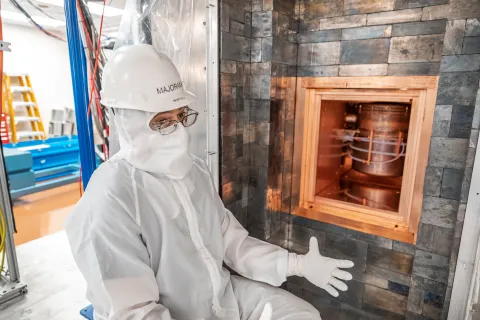
Vincente Guiseppe, co-spokesperson of the Majorana Collaboration and a research staff member at ORNL, in front of the Majorana Demonstrator shield on the 4850 Level of SURF. Photo by Nick Hubbard
“A Majorana particle is one that is indistinguishable from its antimatter partner. This sets it apart from all other particles,” Guiseppe said. “With the Majorana Demonstrator, we are looking for this particle to induce a rare occurrence called neutrinoless double-beta decay.”
Just how rare is this proposed decay? To observe it in just two atoms, you’d have to wait over 1026 years.
“If we watch just one atom, waiting anxiously for it to decay, we would have to watch it for longer than the age of the Universe. To win this game, we have to increase the mass we are watching,” Guiseppe said.
Researchers knew they were unlikely to detect neutrinoless double-beta decay with amount of mass in the Majorana Demonstrator. The collaboration was in a global competition with other current-generation experiments to demonstrate their detector design and technology and to secure a bid for the scaled-up, next-generation experiment.
The Cavern
In 2010, Cabot-Ann Christofferson, a South Dakota Mines chemist with the Majorana Demonstrator, swept her headlamp across the drift nearly a mile underground, watching dust waft through the beam of light. The ground was slick with mud, and the air was warm, thick with humidity. She wondered, “How will this ever be the laboratory we need?”
Because the signal that the collaboration sought was so faint, their detector had to be built at SURF, where 4,850 feet of rock would shield the detector from unwanted “background noise” like cosmic rays on the surface of the Earth.

This photo shows the Majorana Demonstrator cavern before it was outfitted as a laboratory. Photo by Matthew Kapust
The Majorana Demonstrator’s inner detector consisted of 30 kilograms of an enriched isotope of germanium suspended by strings of ultrapure copper and encased in a supercooled cryostat vessel. This inner detector was concealed behind further layers of shielding, including a layer of 108,000 pounds (54 tons) of lead. This structure would be in a cleanroom with as few as 100 particles of dust per cubic foot. Because of the Majorana Demonstrator’s sensitivity, even a few particles of dust or a single bead of human sweat would produce enough background radiation to render the detector useless.
Crews at SURF were tasked with transforming the former mine and its century-old infrastructure into the United States’ deepest underground science laboratory, capable of meeting the high standards of modern research. And the standards were high indeed.
But SURF was invested in the experiment’s success; teams of scientists, engineers, and infrastructure technicians worked closely with the collaboration to create a space tailor-made for the experiment. “Every detail of the facility design reflected the cleanliness protocols and the environment that the experiment required to meet their science goals,” said Jaret Heise, SURF science director.
The floor was reinforced to withstand the weight of the heavy lead shield. The concrete floor was created in a single pour, ensuring that no seams would interfere with the hovercraft used to transport detector modules around the cleanroom. The ragged rock walls were covered with shotcrete and given a smooth finish for easy cleaning.
“The Majorana cleanroom is the cleanest lab space at SURF,” said Heise, noting that the laboratory’s cleaning protocols were informed by world experts in cleanroom operations. “In this laboratory, you must clean according to a detailed process, rather than any visual cue, because you’re often cleaning dirt that can’t be seen.”
This time lapse video shows the Majorana Collaboration building the detector shield in a cleanroom on the 4850 Level of SURF. Time lapse by Matthew Kapust
The Copper
With cavern construction underway, the collaboration got to work on a painstaking process that would prove to be a hallmark of the experiment’s success: electroforming the world’s purest copper.
“We were in a global competition with other experiments, with no time to waste, so we started electroforming in a temporary cleanroom on the 4850 Level, before our permanent cavern was constructed,” Christofferson said.
Electroforming is a fantastically slow process where copper nuggets are first dissolved in a “bath” of ultra-pure sulfuric acid. An electrical current pulls the copper, ion by ion, onto the surface of a metal cylinder. The process slowly forms a layer of exquisitely pure copper at the rate of one millimeter per month, leaving any trace impurities behind.
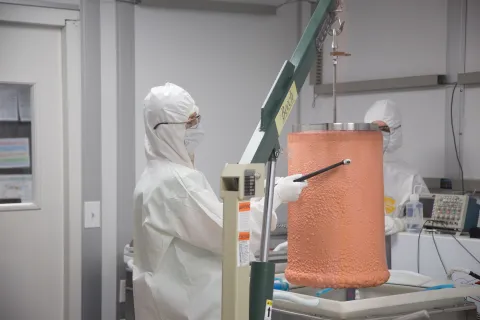
Cabot-Ann Christofferson, a South Dakota Mines chemist with the Majorana Demonstrator, examines a metal cylinder coated with electroformed copper. Photo by Adam Gomez
“The electroforming process creates such pure copper—a percentage with so many trailing nines—the purity couldn’t even be measured at the onset of the experiment in 2011,” Christofferson said. “Today, the technology has advanced, and we can measure the purity to parts per quadrillion.”
Over five years, more than five thousand pounds of copper were grown, then machined into detector components using dedicated tools in an underground machine shop.
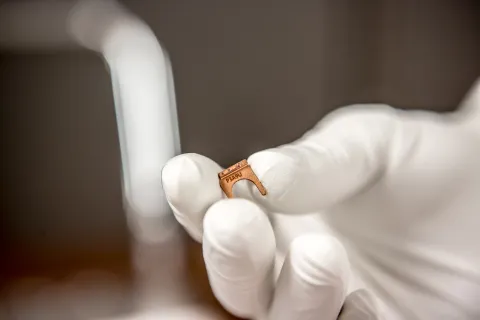
Electroformed copper was machined into thousands of detector components used to build the Majorana Demonstrator. Photo by Matthew Kapust
The Wait
By 2015, the cavern was unrecognizable: The detector was sealed behind a castle-like fortress of lead bricks in a bright, white-walled lab, silently taking in data.
Still, questions lingered. Would their efforts be enough to eliminate background noise? Could this new underground laboratory support world-class science? With the publication of first results in 2017, answers arrived.
While it didn’t detect the particle decay, the Majorana Demonstrator proved that a scaled-up experiment—one that is more than 33 times its size—might be able to do so.
“We created an environment so clean and so pure that we did not see any candidate events in our initial data caused by backgrounds, ” said Guiseppe upon the publication of first results. “We need to continue operating the Demonstrator to study its performance and better estimate the backgrounds.”
The Impact
After their initial science run, the collaboration pressed on, refining their detector design and analysis techniques.
“Even though we aim for as few events as possible, we actually have hundreds of terabytes of data to analyze,” said Ian Guinn, Majorana’s analysis coordinator and a postdoc at University of North Carolina (UNC)-Chapel Hill. “We had to fine-tune our analysis techniques to distinguish between different types of signals, to remove bugs along the way, and to make sure our processes are reliable across five years of data taking. That was a big challenge.”
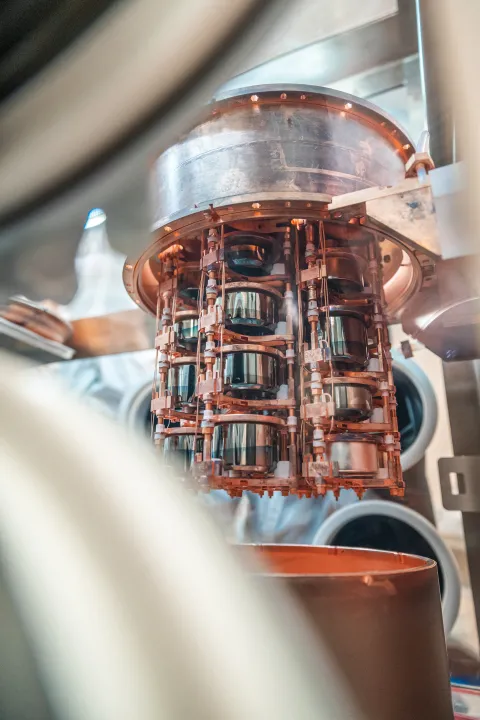
The Majorana Demonstrator’s germanium crystals are suspended in a glovebox in a cleanroom on SURF’s 4850 Level. Photo by Nick Hubbard
With this rich set of data, the collaboration multitasked, adding exotic dark matter searches to their repertoire, as well as searches for possible interactions beyond the Standard Model of particle physics. The collaboration published 27 scientific articles, including six in 2022 and three so far in 2023, with additional papers expected.
The Majorana Demonstrator also provided an environment for scores of undergraduates and more than 25 PhD candidates to gain experience in the design, construction, and analysis of a world-leading experiment.
“Majorana has served as a training ground for a generation of outstanding young physicists,” said John Wilkerson, principal investigator of the experiment and professor of physics at UNC-Chapel Hill. “And I think the experience of our students and postdocs being able to work underground really was fantastic.”
More than 40 South Dakota university students were directly involved with the experiment.
“Students from the rural state of South Dakota worked alongside world-renowned scientists,” Christofferson said. “Without a laboratory like this, students are not going to get that exposure to that level of large-scale science.”
The Future
The Majorana Demonstrator completed its science run in 2021. The collaboration’s triumphs, outlined in their recent publication, include a world-leading energy resolution and a confirmation that the half-life of neutrinoless double-beta decay in germanium-76 is greater than 8.3×1025 years—which is more than a million billion times the age of the Universe.
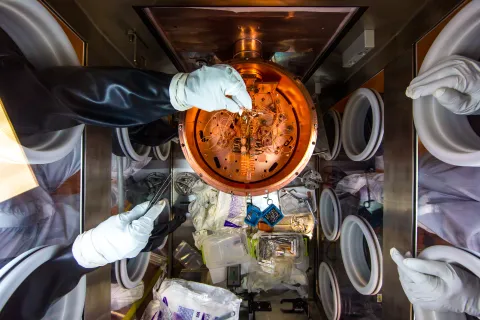
Researchers work on the Majorana Demonstrator’s inner detectors in a glovebox in a cleanroom on SURF’s 4850 Level. Photo by Matthew Kapust
Under the Apennine Mountains of Italy, researchers at Gran Sasso National Laboratory (LNGS), also were studying neutrinoless double-beta decay, employing a slightly different approach with GERDA (GERmanium Detector Array). Together, these two experiments achieved the lowest backgrounds of any neutrinoless double-beta decay experiments in the world. Now, the two are teaming up to scale up.
“Both experiments took different approaches to the same search,” Guinn said. “By combining what proved to be the best ideas from each one, we can create an even more sensitive experiment.”
The next-generation experiment, named LEGEND (Large Enriched Ge Experiment for Neutrinoless ββ Decay), will ultimately use one tonne of enriched germanium to conduct the search. By scaling up exponentially, LEGEND may be able to strong-arm the neutrino into showing its hand.
“When we started this project, there were many risks and no guarantee that we could achieve our goals, as we were pushing into unexplored territory,” Wilkerson said. “Today, we’re one step closer to understanding the imbalance in the Universe—and why we exist at all.”
